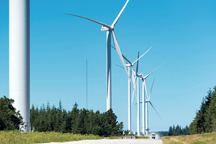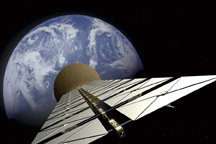

Dear EarthTalk: What is wind repowering and why are environmentalists so bullish on it? ~ H. King, Mesa, AZ
One of the most common forms of clean energy is wind power. People from around the world could recognize a wind farm from just one look. While wind power has been a staple in renewable energy since the idea’s inception, many of the original and old wind turbines have begun to show signs of aging. Wind repowering aims to fix this, by revamping old turbines with more efficient components, or putting in new, state-of-the-art turbines as a whole. These new components and units can reduce noise, more efficiently power a turbine, and a deliver a higher overall energy output.
Denmark, an early adopter of wind repowering, saw a 1.3 GW gain in capacity and a reduction of 109 wind turbines, enabling substantially increased wind energy production with fewer turbines. This promising data prompted a surge in wind repowering projects, and in 2019, 86 percent of wind energy projects there were classified as “repowered.”
These signs of success and scalability showed other countries the benefits of wind repowering. The U.S, with help from large energy corporations like General Electric, has more than 40 active wind repowering sites, with over 2,500 turbines having some type of renovation. This hefty wind repowering advancement is responsible for four gigawatts of energy, or the power for more than 30 million homes.
It’s no secret how fast wind repowering is growing, but upgrades can be made to many different types of renewable energy. Why do eco-advocates support wind repowering so strongly? Wind repowering has energy, financial, aesthetic and technological benefits. Not only does it make units more efficient, it also removes units that might be aesthetically unpleasing, or in less efficient spots than they could be. Wind repowering also increases the lifespan of turbines by as much as 20 years, and reduces the need for maintenance. Repowered turbines are also quieter, sleeker, and produce considerably more energy.
So, while there are many types of repowering efforts for other renewable energy sources, none are as comprehensive or successful as wind repowering. Not only is it a comprehensive option for revamping clean energy, but it does not require the entry costs that just building new wind farms requires.
The only barrier to wind repowering at the moment is legislation. Bills and policies cannot keep up with the demand for it. Readers should call local officials, or urge any nearby wind farms to look at wind repowering. Spreading awareness is the first and most important step.
MORE INFORMATION:
https://www.energy.gov/eere/wind/articles/wind-repowering-helps-set-stage-energy-transition;
https://www.ge.com/renewableenergy/wind-energy/onshore-wind/services/upgrades-refurbishment;
_______________________________________________
Dear EarthTalk: How feasible is creating orbiting solar plants that can beam energy down to Earth? If it’s possible, when can we expect to see such tech implemented? ~ P.R., via email

In the 1941 short story Reason, science fiction author Isaac Asimov introduces a space station that produces energy by sending microwave beams to the planets. This concept is closer to reality as international space programs and research labs test the technology necessary to bring it to life. Traditional solar technologies convert sunlight into usable energy here on Earth. However, their use is limited to daytime hours and restricted by weather and geography. The idea of an orbiting solar plant bypasses these restrictions, allowing energy harvesting above the clouds.
There are different designs, but the principles are similar: A large satellite transforms solar power into electricity using photovoltaic cells made of material that generates voltage and electric current when exposed to light. The power is then beamed down to earth by microwaves (or lasers) to dedicated receiving stations that turn the energy back into electricity to get fed into the local grid.
Entities such as the European Space Agency (ESA), Space Solar (a start-up in the UK), and the California Institute of Technology are investing working on launching this type of project. Besides the obvious benefit of having all sun, all the time, orbiting solar plants have various other benefits. There are no dangerous byproducts as there are for other energy production methods: no fly ash from coal or radioactive waste from nuclear power. The entirely renewable—it will not run out in the age of humanity—so it is harmless could help limit the impacts of climate change if adopted on a global scale.
So why don’t we already have these power-generating stations orbiting in space? There are still challenges to overcome. The cost is prohibitive, the structure would need to be about 2,000 metric tons, roughly equivalent to the weight of 286 male African elephants and need to be a mile and a quarter in diameter, with a little over a half-mile-long transmitter. Another challenge is engineering, particularly the parts used for such power-beaming structures. Given the difficulty of reaching the satellites for maintenance and repairs, it is suggested that parts must withstand at least 15 years in space. Additionally, there’s a need to improve the efficiency of current wireless power transmission to ensure that all the energy can be collected down to Earth.
There are some significant drawbacks, too. Solar plants orbiting closer to Earth would transmit energy more easily, but light pollution would be difficult for humans and both flora and fauna to cope with. Research also suggests that exposure to artificial light at night can increase health issues in humans, including obesity, depression, diabetes and more.
Whether Asimov’s proposal from nearly a century ago will be implemented remains to be seen. The ESA has recently sought ideas to make it more feasible. “The potential of this concept to contribute to long-term sustainable energy is very high,” says ESA Engineer Advenit Makaya. For the time being, you can invest in solar power on Earth and keep your eyes on the sky as the technology advances and costs drop.
MORE INFORMATION:
https://spacenews.com/nasa-study-clean-space-based-solar-power-beaming-possible/.
_______________________________________________
Dear EarthTalk: What have been the most dramatic effects of global warming on Africa and what do longer-term climate projections foretell for Africa’s future? ~ William C., Raleigh, NC

Global warming has already had profound impacts on Africa, which is already grappling with many environmental and socio-economic challenges. The most dramatic effects observed so far include increased temperatures, changes in precipitation patterns, and a rise in extreme weather events—all of which have far-reaching consequences for the environment, agriculture and human livelihoods.
Temperatures across Africa have risen significantly in recent decades, with some regions experiencing increases twice the global average rate. This exacerbates existing problems, particularly in arid and semi-arid regions. Prolonged heat waves and severe droughts have become more frequent, threatening water supplies and agricultural productivity.
Changes in precipitation are another significant impact. Some regions have seen decreased rainfall, while others face more intense and erratic rainfall. The Sahel, a semi-arid region south of the Sahara Desert, has experienced both prolonged droughts and intense rainfall, leading to flash floods. These shifts disrupt farming practices, erode soils and reduce crop yields, exacerbating hunger and poverty.
Extreme weather events ever more frequent and severe. Southern Africa, particularly Mozambique, has faced devastating cyclones like Idai in 2019, which caused extensive damage, and displaced or killed thousands. Flooding destroys homes and crops and facilitates waterborne diseases.
Long-term climate projections for Africa paint a grim picture. By the end of the 21st century, average temperatures are expected to increase, leading to more severe heatwaves and droughts. Water scarcity will intensify, particularly in North and Southern Africa, where river flow and groundwater recharge rates are projected to decline. Agriculture, which employs a large portion of the population, faces dire challenges. Staple crops such as maize, sorghum and millet are expected to see reduced yields, a productivity decline that threatens food security and could increase dependence on food imports, straining economies further.
Coastal areas are at risk, too, from rising sea levels. Cities like Lagos, Nigeria and Alexandria, Egypt are particularly vulnerable to coastal erosion and flooding. Mangrove ecosystems, vital for coastal protection and fisheries, are also threatened by sea level rise and changing salinity patterns. Biodiversity loss is another critical concern. Many of Africa’s unique ecosystems, such as the Congo Basin rainforests and the savannas, could be drastically altered. Species that cannot adapt to rapidly changing conditions face extinction, disrupting ecological balances and affecting livelihoods dependent on natural resources.
“Africa is responsible for less than 10 percent of global greenhouse gas emissions,” says the World Meteorological Organization’s Secretary-General Petteri Taalas. “But it is the continent which is the least able to cope with the negative impacts of climate change.” Promoting resilient infrastructure, sustainable agriculture and regional cooperation are crucial to a sustainable future for its people.
MORE INFORMATION:
https://wmo.int/media/news/africa-suffers-disproportionately-from-climate-change.
_______________________________________________
EarthTalk® is produced by Roddy Scheer & Doug Moss for the 501(c)3 nonprofit EarthTalk. See more at https://emagazine.com. To donate, visit https://earthtalk.org. Send questions to: question@earthtalk.org.

